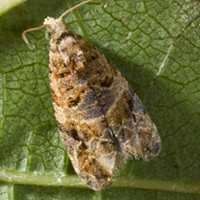The Discovery Of The European Grapevine Moth

|
European grapevine moth larvae |
A new pest has made its way across the pond and into California’s Napa County. First discovered in the Oakville area in September 2009, European grapevine moth is a lepidoptera moth. But, according to statewide IPM advisor Lucia Varela, it’s very different from pests like light brown apple moth, because it does not feed on leaves at all, but instead on the berries.
Life Cycle
European grapevine moth has three generations. The first generation — the larvae — will appear in flower clusters as the flowers are developing, Varela says. Females in the second generation lay single eggs on top of berries, and potentially, a vine could have as many larvae as berries. “In essence, that’s why it’s so serious,” Varela says. “The female lays an egg and then puts a pheromone down on that berry, deterring other females from laying an egg on that berry. The larvae goes inside that berry, so it’s assigning its young a particular berry. But at the end of the day, you could have many, many worms, because you can have one worm per berry.”
One of the symptoms to look out for in early spring is flower clusters that appear to be clumped together, which can be a sign that larvae are inside laying silk. Later in the season, the second generation enters the berries, causing them to become soft and wrinkled. “As you’re walking quickly down the rows, what should catch your attention is that the berries are wrinkling. They enter the berry where two berries are touching, so you’re not going to see the hole,” Varela says. “Then if you get closer and you open up that bunch, you would see the webbing and holes in the berries.”
Managing An Infestation
The good news for growers, Varela says, is that there is chemistry available to fight European grapevine moth both conventionally and organically. For organic growers, Bt and Entrust (spinosad, Dow AgroSciences) are two options to consider. “But if you’re infested, you’re going to have to spray,” she says.
Another up-and-coming product from Pacific Biocontrol — Isomate, a pheromone for mating disruption — was recently registered for use on European grapevine moth. It should be commercially available for the beginning of the second generation of European grapevine moth this season, Varela says.
Chemistry aside, Varela says the most important tool to fight European grapevine moth infestation is sanitation. “It is crucial that growers practice sanitation always, because you don’t know what [pest] has arrived that you have not yet noticed,” she says. “Anything that touches the fruit should be sanitized before entering any other vineyards, whether it’s clean or dirty,” she adds. That includes mechanical harvesters, bins, etc. “Sanitation should be like washing your hands after you go to the bathroom. You have to do it,” she says. “I think in the long run for the benefit of their own vineyards, it is good to institute sanitation practices, because it pays off.”
While the infestation currently appears to be limited to the Napa area, Varela says she’s not sure if the pest will affect grapes elsewhere in the state. The California Department of Food and Agriculture (CDFA) has already started setting traps up and down the state, so this proactive approach could be the key to averting devastation. “This would be really bad news for table grapes,” Varela notes. “Controlling it is one issue, but then export restrictions are a whole new issue.” If the pest ends up in table grapes, exporting to places like Australia, New Zealand, China, and other countries could become tricky due to tough restrictions. “I’m not suggesting that’s what they’re going to do, but it could come to that,” she says. “So it’s better not to have the pest.”










